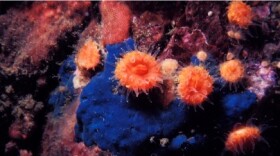They’re the tools of modern-day warfare: unmanned aircraft systems better known as drones.
They’re also being tested to help carry out important scientific missions, including surveys of wildlife and marine debris in the National Marine Sanctuary off the coast of the Olympic Peninsula.In the marina at La Push aboard the research vessel Tatoosh, two pilots dressed in dark blue uniforms run a pre-flight check on a Puma unmanned aircraft system. They’re with the National Oceanic and Atmospheric Administration, the federal science agency that studies changes in our environment.
One stays inside the cabin using remote controls to move the aircraft while the other holds it aloft. With a quiet electric motor and a wingspan just over 9 feet, it seems a lot like an oversized model airplane. And NOAA pilot Tanner Sims says they can launch it almost anywhere, kind of like flying a kite.
“That’s actually one of the unique benefits of the small aircraft, is that we don’t need a runway," Sims said. "We literally throw it off into the air. And then when we need to recover it, it floats. And so we literally just splash it into the water and pick it up.”
The ability to just pack up a system and use it from the deck of a ship is the Holy Grail for NOAA, says project scientist Todd Jacobs. It’s basically a high-definition flying camera with infrared capabilities that scientists use to extend their reach.
“So we can go into remote areas on our vessels and be able to launch and recover these systems,” Jacobs said.
Together with the Coast Guard, they’re testing the Puma as an advance warning system to help the icebreaker Healy chart its course, and also as a tool for surveying potential oil spills in and under the ice. It has also been tested as a search and rescue tool in Florida. And Jacobs says it could eventually be used to enforce environmental law and help regulate fisheries.
“There are several things they do really well, and we’re identifying those and making those the priority missions for the systems,” Jacobs said.
Here on the Olympic Coast, they’re testing it to catalog marine debris—and to carry out surveys of sensitive seabirds that live on top of steep rocks and refuge islands in the marine sanctuaries. Their population trends serve as an indicator of general ocean health. Sue Thomas, a wildlife biologist with the U.S. Fish and Wildlife Service, says the current method of using helicopters with photographers inside often disturbs the birds and other creatures. She says the stealthy qualities of a military drone seem to be ideal for spying on wildlife.
“So far, it seems like it’s working much, much better," Thomas said. "We’ve hardly noticed any disturbance whatsoever in four days of flights. And we’re collecting very good data, good photos.”
The best photos are coming from a second unmanned aircraft they’ve been testing: a small quadcopter that looks like a toy helicopter. The Puma’s sensors aren’t yet matching the resolution coming from the quadcopters or traditional methods using manned aircraft. But, she says, the miniature airplanes are still very promising.
“The most exciting thing for me is we’ve flown over a raft of sea otters and were able to collect some video footage of that raft," Thomas said. "They didn’t appear to notice the Puma flying over. And in fact, we had one sea otter on the outside of the raft doing somersaults in the water, which is just such an exciting behavior. You don’t normally see that when you’re flying over or particularly if you’re going past them in a boat.”
With unmanned aircraft, they can hover much closer. It’s safer for the people involved. And they’re so much cheaper than traditional methods, Thomas says they could keep the surveys going and make them better even in the face of federal cuts due to sequestration.
“It’s another way to improve our science. It’s a way to reduce the disturbance, which is one of our highest management priorities and, at the same time, collecting good data on populations,” Thomas said.
And, to make the wildlife surveys more complete, NOAA’s Jacobs says the agency is hoping to eventually get permission from the National Parks Service to launch them in wilderness areas.
So what about privacy? Should you expect to have your beach walk, sailing trip or hike intruded upon by a small drone working for the government? Jacobs says probably not.
“It is possible in the future that we will be using these things regularly. But not often, if at all, in places that people may be walking on the beach. We’re really using these in remote places,” Jacobs said.
And he says these things are going to be surveyed one way or another. So if a drone provides the way that’s safest, cheapest and best for the environment, that’s what they want to do.












